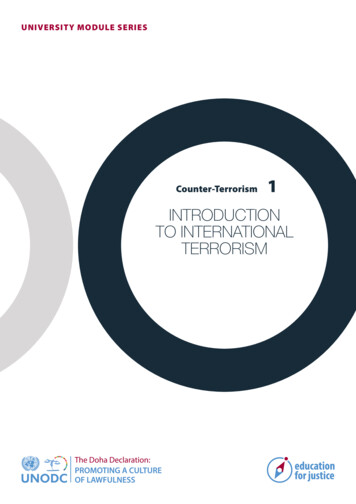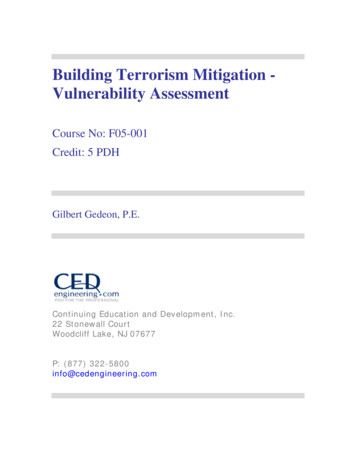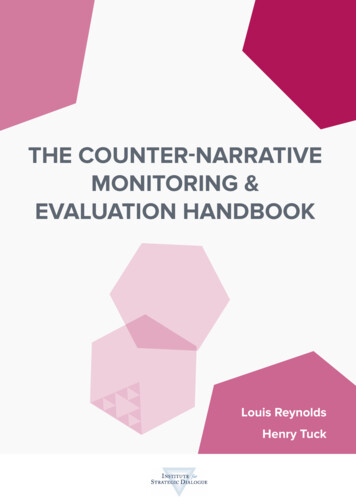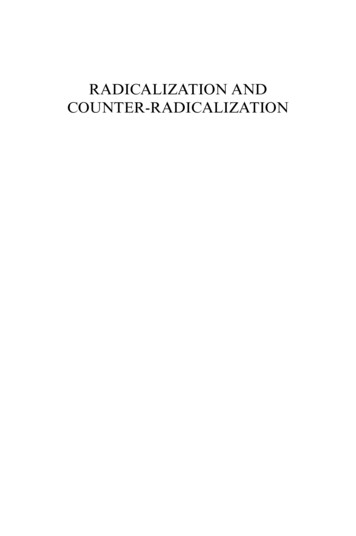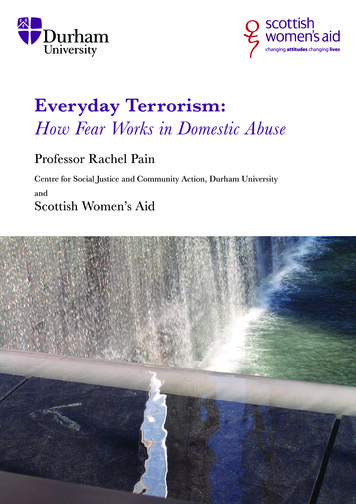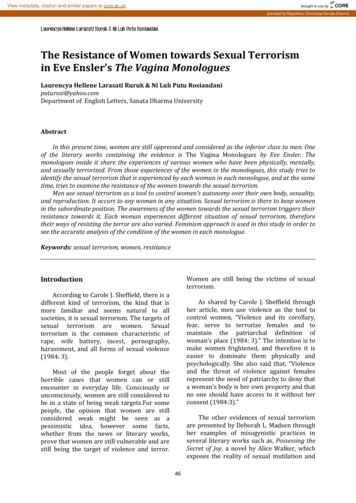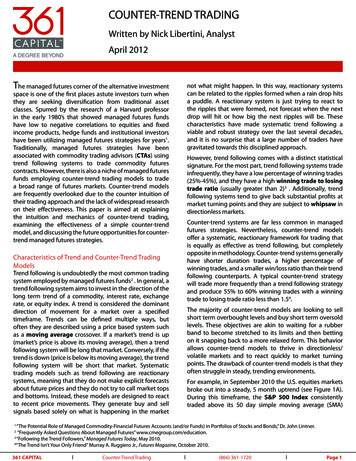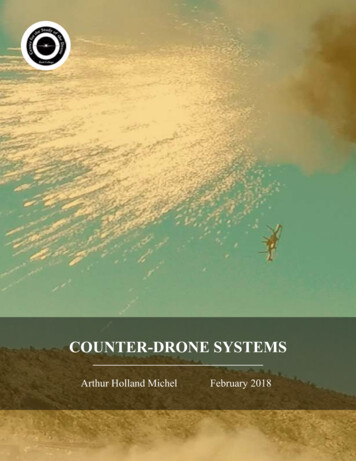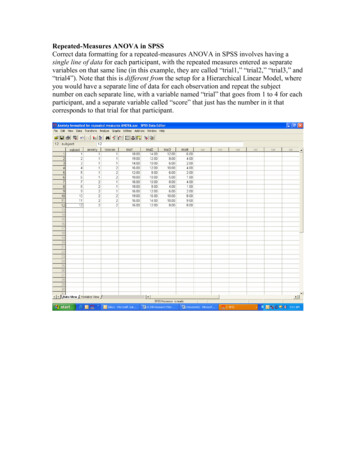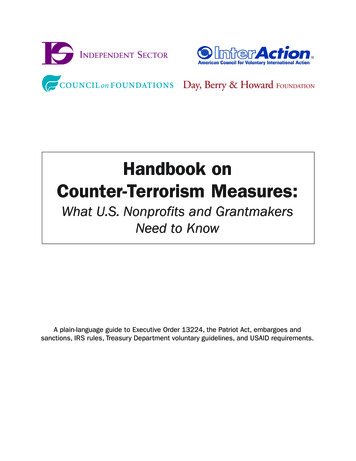
Transcription
Day, Berry & Howard FOUNDATIONHandbook onCounter-Terrorism Measures:What U.S. Nonprofits and GrantmakersNeed to KnowA plain-language guide to Executive Order 13224, the Patriot Act, embargoes andsanctions, IRS rules, Treasury Department voluntary guidelines, and USAID requirements.
TABLE OF CONTENTSPagePRELIMINARY NOTE .iiiEXECUTIVE SUMMARY . vI.BACKGROUND AND OVERVIEW OF COUNTER-TERRORISM RULES . 1II.EXECUTIVE ORDER 13224. 2Summary . 2Background of Executive Order 13224 . 3What is the legal status of the Executive Order? . 3What does the Executive Order do?. 4Where to look to identify known or suspected terrorists relevant under theExecutive Order. . 5What does “terrorism” mean, as used in the Executive Order?. 6Is knowledge or intent required to violate the Executive Order? . 6What types of transactions might trigger the restrictions of the Executive Order inthe charitable or humanitarian context?. 6Will a grant or other support to an organization or individual that is not listed inany of the lists at the time of the transaction be the basis for asset blockingor other action under the Executive Order if the organization or individualis later added to a relevant list?. 8What about funding an organization that might receive support from a CoveredParty – Must donors also be checked?. 8What we can learn from Executive Order court cases to date? . 9III.THE PATRIOT ACT AND RELATED LAWS. 10Summary . 10What is the Patriot Act and how does it relate to nonprofits and grantmakers?. 10What is “material support for terrorism”? . 11What are the penalties for providing material support for terrorism? . 12The crime of financing terrorism . 12What is a “willful,” “knowing” or “intentional” violation?. 12Where to look to identify known or suspected terrorists relevant under the PatriotAct. 13Potential civil liability under the Patriot Act . 13What can we learn from the Patriot Act court cases? . 14IV.EMBARGOES AND TRADE SANCTIONS . 15Summary . 15What are embargoes and trade sanctions? . 15Who administers embargoes and trade sanctions and how do they work?. 16What exceptions are available for charitable work in embargoed countries andregions? . 16-i-
V.IRS RULES. 17Summary . 17The general non-diversion prohibition. 17Existing IRS rules governing foreign grantmaking and expenditures . 18New IRS Counter-Terrorism Measures? Internal Revenue Service Announcement2003-29 . 19VI.TREASURY GUIDELINES – “VOLUNTARY BEST PRACTICES”. 20Summary . 20Where did the Voluntary Treasury Guidelines come from?. 20What is the legal status of the VoluntaryTreasury Guidelines? . 21What do the Voluntary Treasury Guidelines tell us about the perspective of thelaw enforcement officials within the Treasury Department?. 21What do the Voluntary Treasury Guidelines contain?. 22VII.ADDITIONAL REQUIREMENTS FOR ORGANIZATIONS FUNDED BY THEUNITED STATES AGENCY FOR INTERNATIONAL DEVELOPMENT. 23Summary . 23Background . 23The USAID Certification Requirements. 24Violation of the USAID Certification Requirements. 25VIII.CONCLUSION” . 25-ii-
PRELIMINARY NOTEThis Handbook depicts the state of the law with respect to counter-terrorism measures and U.S.nonprofits and grantmakers as of March 15, 2004. This is a fast-developing area of the law, andreaders are advised to consult qualified legal counsel regarding possible subsequent changes oradditional issues relevant to their particular situations.The primary authors of this Handbook are Edgardo Ramos, Timothy R. Lyman, Patricia Canavanand Clifford Nichols III, who are all lawyers affiliated with the law firm of Day, Berry &Howard LLP (www.dbh.com). Invaluable research assistance was provided by Eric R. Jones,also of Day, Berry & Howard LLP.This Handbook was produced for INDEPENDENT SECTOR, InterAction and the Council onFoundations under the auspices of the Day, Berry & Howard Foundation(www.dbhfoundation.org). The mission of the Day, Berry & Howard Foundation is “to promotepositive developments in the law, legal scholarship and legal education, locally, nationally andinternationally.” Peter Shiras, Senior Vice President of INDEPENDENT SECTOR, Mary E.McClymont, President of InterAction, Janne G. Gallagher, Vice President and General Counselof the Council on Foundations, Cynthia Carr, General Counsel of InterAction member Save theChildren (US), and Tim Burgett, Senior Legal Counsel of InterAction member World VisionInternational, contributed importantly to the scope, text and practical applicability of the analysisprovided here.This Handbook is not intended by INDEPENDENT SECTOR, InterAction, the Council onFoundations, the Day, Berry & Howard Foundation or Day, Berry & Howard LLP as legaladvice, and readers are advised to consult qualified legal counsel as to their particularsituations. 2004 Day, Berry & Howard Foundation, Inc.Permission is hereby granted for the copying and distribution of this Handbook in its entirety only, and not inpart, for use by nonprofit organizations and grantmakers. No other use is permitted which will infringe thecopyright without the express written consent of the Day, Berry & Howard Foundation, Inc.The respective logos of INDEPENDENT SECTOR, InterAction and the Council on Foundations are the servicemarks of each organization and are used with their permission. They have no responsibility for the contentsof this Handbook.-iii-
INDEPENDENT SECTOR is a nonprofit, nonpartisan coalition of approximately 600 nationalorganizations, foundations, and corporate philanthropy programs, collectively representing tensof thousands of charitable groups in every state across the nation. Its mission is to promote,strengthen, and advance the nonprofit and philanthropic community to foster private initiative forthe public good. www.independentsector.orgInterAction is the largest alliance of U.S.-based international development and humanitariannongovernmental organizations. With more than 160 members operating in every developingcountry, we work to overcome poverty, exclusion and suffering by advancing social justice andbasic dignity for all. www.interaction.orgThe Council on Foundations is a membership organization of more than 2,000 grantmakingfoundations and giving programs worldwide that serves the public good by promoting andenhancing responsible and effective philanthropy. The Council provides leadership expertise,legal services and networking opportunities – among other services – to its members and to thegeneral public. www.cof.orgThe Day, Berry & Howard Foundation is affiliated with the law firm of Day, Berry & HowardLLP and promotes positive developments in the law, legal scholarship and legal education,locally, nationally and internationally. www.dbh.com and www.dbhfoundation.org-iv-
EXECUTIVE SUMMARYSince September 11, 2001, U.S. nonprofits and grantmakers of all types have grown increasinglyconscious of their responsibility to prevent their funding or activities from assisting terrorists.This Handbook describes in plain language the most critical counter-terrorism measures in effectas of March 15, 2004 of relevance to U.S. nonprofits and grantmakers.Executive Order 13224In response to the September 11th terrorist attacks, President Bush issued an extremely broadExecutive Order that prohibits transactions with individuals and organizations deemed by theExecutive Branch to be associated with terrorism and allows the government to freeze all assetscontrolled by or in the possession of these entities and those who support them. The ExecutiveBranch has taken the position that it has the authority to freeze assets while it investigateswhether an organization is associated with terrorism. The lists of individuals and organizationsdeemed to be associated with terrorism are constantly growing and changing; but the reach of theExecutive Order is broader than those appearing on the lists, and also extends potentially toindividuals and organizations who could be listed in the future because of associations withterrorists or acts of terrorism. However, it seems extremely unlikely that enforcement actionwould be taken against nonprofits and grantmakers for a transaction with an unlisted party,presuming there were not other circumstances surrounding the transaction that signaled caution.The Executive Order applies to all “U.S. persons,” including organizations and individualsregardless of where they (or their property) are located, and it extends to transactions andproperty within the United States, property that subsequently comes within the United States, orproperty that is in the possession of any person or entity located within the U.S. Prohibited typesof transactions include financial support, in-kind support and even technical assistance.Humanitarian assistance is also covered, if it is rendered to persons associated with terrorists oracts of terrorism. Importantly, an organization can violate the Executive Order, and couldconsequently have its assets frozen (or face other unspecified enforcement action), even if it doesnot know it is providing support to parties associated with terrorism.The Patriot Act and Related LawsPrior to September 11, 2001, Federal law included criminal sanctions for persons who providematerial or financial support for terrorism or for Foreign Terrorist Organizations. On October26, 2001, President Bush signed the Patriot Act into law, which contains various measuresdirected at strengthening the Federal government’s ability to combat terrorism. As amended bythe Patriot Act, Federal law now imposes significant fines and terms of imprisonment for anyentity that provides material support or resources knowing or intending that they are to be used interrorist acts or by Foreign Terrorist Organizations. “Material support” encompasses anexceptionally broad range of assistance, and would appear on its face clearly to include grants,microfinance services and many types of technical assistance – if the recipient engages interrorist acts or is a Foreign Terrorist Organization. At the end of June 2002, the Federalcriminal law was again supplemented, this time to criminalize the “financing of terrorism.” Thisnew provision punishes an individual or organization who “willfully provides or collects funds-v-
with the intention that such funds be used” to carry out acts of terrorism or who knowinglyconceals the source of funds used to carry out terrorism or to support Foreign TerroristOrganizations. Finally, nonprofits and grantmakers must be concerned with potential civilliability should their grants or other types of assistance end up in the wrong hands, because thePatriot Act also provides private parties with a civil cause of action against those who providematerial or financial support for terrorism.Embargoes and Trade SanctionsEmbargoes and trade sanctions have been critical weapons in the government’s anti-terrorismarsenal since long before the September 11 attacks. Enforcement has increased, however, so thatnow even inadvertent violations in the charitable or humanitarian context are much less likely tobe overlooked. Although specific provisions vary, embargoes are often broad enough toencompass grants to a nonprofit that provide for the transfer of goods, services or other resourcesto the embargoed country. Violators of U.S. embargoes are potentially subject to substantialcivil and criminal penalties, unless the activities fall within an exemption, which commonlyinclude narrowly defined humanitarian emergency relief activities and transactions relating toinformational materials. Under certain circumstances, a license from the Treasury or CommerceDepartment may be required.IRS RulesThe United States tax laws generally prohibit the diversion of charitable assets to any noncharitable purpose, including material or financial support of terrorism. A public charity orprivate foundation risks the revocation of its tax-exempt status when it violates this prohibition.In addition, in 2003 Congress amended the Tax Code to provide for the automatic, retroactivesuspension of tax-exempt status for an organization designated as a terrorist organization underany of the relevant legal authority discussed in this Handbook. Although the non-diversionprohibition applies equally to the use of charitable assets within and outside the U.S., additionalrules govern grantmaking and expenditures outside the U.S. These have not yet changed toprovide any new measures aimed specifically at combating terrorism.Treasury Guidelines – “Voluntary Best Practices”The Voluntary Treasury Guidelines, which were issued by the Treasury Department to assistnonprofits and grantmakers in complying with the Executive Order and the Patriot Act, describeso-called “best practices” for the manner in which internationally active foundations andnonprofits are organized and run, and provide an outline of a proposed anti-terrorist financingcompliance program for such organizations. The Voluntary Treasury Guidelines do not have theforce of law, nor do they ensure that organizations that comply with them will be safe from assetblocking, loss of tax-exempt status or civil or criminal liability. However, they do provideinsight into the government’s interpretation of the various legal rules discussed elsewhere in thisHandbook, including its view that any support for terrorism, irrespective of the knowledge orintentions of the parties involved, may be subject to enforcement action. The VoluntaryTreasury Guidelines consist of four sections, of which the fourth section, dealing with antiterrorist financing procedures, has proved the most controversial and problematic. This sectionproposes that internationally active foundations and nonprofits attempt to implement compliance-vi-
programs similar to those that are already legally required of private financial institutions byvarious Federal laws. Many of the specific recommendations would have an organizationconducting extensive due diligence concerning all organizations and individuals with which ittransacts its affairs, including not just foreign grantee organizations and partners but also foreignvendors and financial institutions used in carrying out foreign grantmaking and programming.Additional Requirements for Organizations Funded by USAIDThe United States Agency for International Development has instituted certificationrequirements that apply to all USAID funding recipients to assure that USAID does not directlyor indirectly support terrorist groups or individuals. USAID requires an applicant for funding tostate that it has not provided, and will not provide, material support or resources to anyindividual or entity (or an agent) that it knows or has reason to know advocates, plans, sponsors,engages in, or has engaged in terrorist activity. The certification is an express term and conditionof all USAID agreements for funding and violation of the certification requirement is grounds forunilateral termination of the agreement by USAID.-vii-
I.BACKGROUND AND OVERVIEW OF COUNTER-TERRORISM RULESSince September 11, 2001, U.S. nonprofits and grantmakers of all types have grown increasinglyconscious of their responsibility to prevent their funding or activities from assisting terrorists.Highly publicized cases involving a few nonprofit charitable organizations accused of directassistance to foreign terrorist organizations and statements by some public officials about aperceived widespread use of charitable organizations to raise and channel funding for terrorismhave contributed to a growing sense of concern. Public debate on the appropriate boundariesbetween security and liberty (and the urging of some to revisit measures already taken in thegovernment’s efforts to combat terrorism) have also served to heighten awareness amongnonprofits and grantmakers that the environment for carrying out their activities has changedmarkedly.But what, specifically, has changed? What types of organizations and what activities areaffected? Is it only internationally active organizations that should be concerned, or are therereal concerns for all organizations? Many U.S. nonprofits and grantmakers are unsure.This Handbook explains in plain language the most critical counter-terrorism measures in effectas of March 15, 2004 of relevance to U.S. nonprofits and grantmakers. The aim is to clarify thevarious measures that pre-date September 11, 2001 and those that have been introduced sincethen, which measures have the force of law and which are merely advisory, what the possibleramifications might be for noncompliance and what we can learn from the emerging counterterrorism court cases.We address the following topics: We begin in Part II with Executive Order 13224, signed by the President within days of theSeptember 11 attacks, which calls for asset blocking of organizations held to have providedmaterial support for terrorism.In Part III we discuss relevant provisions of the USA Patriot Act and related legislation thatcreate or enhance criminal sanctions for providing material support for terrorism and providefor possible civil liability for the organizations and individuals involved.Part IV explains how counter-terrorism-focused embargoes and trade sanctions work, whatthe consequences may be for organizations that violate them and what sorts of exceptionsmay be available.In Part V we outline the relevant IRS rules and explain how the diversion of charitable fundsto support terrorism can result in the revocation of tax-exempt status.Part VI discusses the Treasury Department’s “Anti-Terrorist Financing Guidelines:Voluntary Best Practices for U.S.-Based Charities,” which do not have the force of law, butwhich provide insights into the law enforcement community’s perspective on the othercounter-terrorism measures discussed.Part VII addresses the counter-terrorism measures applicable to organizations that receivefunding from the United States Agency for International Development to carry out theirwork, violation of which can result in unilateral termination of the USAID agreement, andpossible other adverse consequences, depending on the specific circumstances.
Many of the counter-terrorism measures discussed predate the attacks of September 11; othersspecifically respond to those events. In both cases, however, the climate for enforcement haschanged, meaning that inadvertent violations may be less likely to be overlooked. As awarenessof these issues grows among nonprofits and grantmakers alike, nonprofits are already findingthey need to demonstrate their understanding of counter-terrorism measures – both to thegovernment and to their funders. We hope a better understanding of these measures will help allU.S. nonprofits and grantmakers carry out their important work in this changed environment.A preliminary word is in order regarding a set of topics not covered by this Handbook – thespecific steps that different organizations need to take in order to ensure compliance with therules discussed. There are several reasons why these topics are not addressed here at this time: II.The Handbook covers a wide range of different types of legal measures employed tocombat terrorism. Appropriate compliance measures must be tailored carefully to fit thedifferent kinds of measures and the specific relevant activities of the U.S. nonprofit orgrantmaker in question.These are collectively very fast-developing areas of the law, with new developmentsoccurring more or less constantly. Any comprehensive attempt at compliance guidanceat this time would therefore probably be quickly outdated.The audience for this Handbook is exceptionally broad, encompassing every differenttype of U.S. nonprofit charitable organization and every type of U.S. grantmaker, boththose that are internationally active and those only active here in the U.S. There is no“one-size-fits-all” approach to compliance that will be appropriate to the situation of allsuch organizations. Each organization, once it has familiarized itself with the broad newlandscape of counter-terrorism measures, should seek qualified compliance advicespecific to its situation.Neither the organizations for which this Handbook is intended nor lawyers qualified toprovide advice in these areas have reached consensus as to what specific subgroups oforganizations should do to comply with each of the different bodies of rules discussed.Important work is underway, also, to seek guidance and clarification from variousrelevant governmental bodies – principally the Treasury Department – that will likelyhave a strong bearing on any general compliance advice that may ultimately be given, aswill further court decisions interpreting the various legal issues discussed.EXECUTIVE ORDER 13224Summary. In response to the September 11th terrorist attacks, President Bush issued anextremely broad Executive Order that prohibits transactions with individuals and organizationsdeemed by the Executive Branch to be associated with terrorism and allows the government tofreeze all assets controlled by or in the possession of these entities and those who support them.The Executive Branch has taken the position that it has the authority to freeze assets while itinvestigates whether an organization is associated with terrorism. The lists of individuals andorganizations deemed to be associated with terrorism are constantly growing and changing; butthe reach of the Executive Order is broader than those appearing on the lists, and also extendspotentially to individuals and organizations who could be listed in the future because of-2-
associations with terrorists or acts of terrorism. However, it seems extremely unlikely thatenforcement action would be taken against nonprofits and grantmakers for a transaction with anunlisted party, presuming there were not other circumstances surrounding the transaction thatsignaled caution. The Executive Order applies to all “U.S. persons,” including organizationsand individuals regardless of where they (or their property) are located, and it extends totransactions and property within the United States, property that subsequently comes within theUnited States, or property that is in the possession of any person or entity located within the U.S.Prohibited types of transactions include financial support, in-kind support and even technicalassistance. Humanitarian assistance is also covered, if it is rendered to persons associated withterrorists or acts of terrorism. Importantly, an organization can violate the Executive Order,and could consequently have its assets frozen (or face other unspecified enforcement action),even if it does not know it is providing support to parties associated with terrorism.Background of Executive Order 13224. One of the Federal government’s first responses to theterrorist attacks of September 11, 2001 was President Bush’s signing of Executive Order 13224entitled “Blocking Property and Prohibiting Transactions With Persons Who Commit, Threatento Commit, or Support Terrorism” (the “Executive Order”).1 As its title suggests, the ExecutiveOrder’s general aim is to cut off resources to terrorists and terrorist organizations through assetblocking.Essentially, the Executive Order prohibits transactions with individuals and organizationsdeemed by the Executive Branch to be associated with terrorism and blocks any assets controlledby or in the possession of such entities and those who support them. Although the restrictions ofthe Executive Order are certainly not limited to nonprofits and grantmakers, the Executive Orderhas potentially far-reaching significance for them.What is the legal status of the Executive Order? The Executive Order is not a law per se but itcarries the force of law in that it represents the President’s exercise of statutory authority grantedby Congress under the International Emergency Economic Powers Act (“IEEPA”) and theNational Emergencies Act.2 In the case of Executive Order 13224, President Bush declared anational emergency on September 14, 2001, which he has continued in effect ever since.31Exec. Order No. 13,224, 66 Fed. Reg. 49,079 (Sept. 25, 2001), amended by Exec. OrderNo. 13,258, 67 Fed. Reg. 44,751 (July 3, 2002) & Exec. Order No. 13,284, 68 Fed. Reg. 4,075(Jan. 28, 2003) [hereinafter Exec. Order No. 13,224], available ions/t11ter.pdf. Almost two years later, on June6, 2003, pursuant to the authority granted to it by Section 7 of the Executive Order, the Office ofForeign Assets Control of the Treasury Department issued regulations to implement theExecutive Order, entitled “Global Terrorism Sanctions Regulations.” Those regulations can befound at 31 C.F.R. Part 594 and additional commentary to those regulations can be found at 68Fed. Reg. 34,196 (June 6, 2002), available 2International Emergency Economic Powers Act, 50 U.S.C. §§1701-1707; NationalEmergencies Act, 50 U.S.C. §§ 1601-1651. IEEPA has been used previously in the counterterrorism arena. For example, on January 23, 1995, President Clinton declared a national-3-
What does the Executive Order do? The Executive Order freezes all property and interests inproperty of certain “persons” (both individuals and organizations) identified as terrorists,controlled by terrorists, supporters of terrorists or otherwise associated with terrorists. Moreimportantly for the purposes of nonprofits and grantmakers, the Executive Order expresslyprohibits donations to such individuals and organizations and all transactions involving propertyor property interests frozen under the Executive Order. For the purposes of this Handbook theseindividuals and organizations are identified as “Covered Persons.”Covered Persons whose property and interests are automatically frozen are: (1) those specificallylisted in the Annex to the Executive Order itself;4 (2) those determined by the Secretary of State“to have committed, or to pose a significant risk of committing, acts of terrorism that threaten thesecurity of U.S. nationals or the national security, foreign policy, or economy of the UnitedStates”;5 and (3) those determined by the Secretary of the Treasury “to be owned or controlledby, or to act for or on behalf of” Covered Persons.6emergency with respect to “grave acts of violence committed by foreign terrorists that disrupt theMiddle East peace process” and invoked the authority of IEEPA. Exec. Order No.12,947, 60Fed. Reg. 5,079 (Jan. 23, 1995). One year late
This Handbook describes in plain language the most critical counter-terrorism measures in effect as of March 15, 2004 of relevance to U.S. nonprofits and grantmakers. Executive Order 13224 In response to the September 11th te
